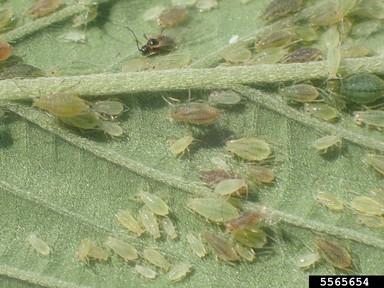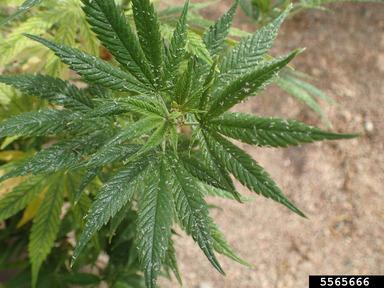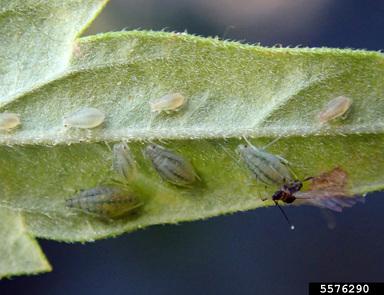Overview
Scientific Name
Phorodon cannabis
Type
Insect
Leaf Condition
Wilting and leaf yellowing
Season
Pre-harvest, harvest
Cropping System
Hemp and potentially hops

Mixed life stages of cannabis aphid on hemp. Photograph taken September 11, 2017.
Whitney Cranshaw, Colorado State University, Bugwood.org CC BY 4.0
Biology
The cannabis aphid (Phorodon cannabis) is newly recognized in North America, and has been found in several US states and parts of Canada. In the early part of the growing season, the cannabis aphid is a light cream to pale yellow color. In late season as the day length shortens, it changes to a range of light green, to pale pink, to light brown. It is found on the leaves and stems where it uses its piercing-sucking mouthparts to feed on the plant fluids, specifically phloem.
Like most other aphids, the cannabis aphid has a complex life cycle. Wingless females can reproduce parthenogenetically ("self-cloning") or they can mate with winged males to reproduce sexually. The eggs are laid following sexual reproduction and are typically found on seed capsules. Eggs are initially yellow-green, but turn black as they harden. Winged forms are common in late summer, and eggs laid by these adults overwinter. Immature aphids, called nymphs, can mature within a couple weeks of birth, this means populations have the potential to increase rapidly. Fortunately, a wide variety of natural enemies eat aphids and can help control the rate of growth.
Cannabis aphid is very similar in appearance to hop aphid, Phorodon humuli, and can only be distinguish through closely examining the area at the front of the head under a microscope. Distinctive characteristics of the cannabis aphid include the horn-like projections at the base of antennae and bulb tipped setae (hairs) on the head, thorax, and base of antennae. Green peach aphid (Myzus persicae), cotton/melon aphid (Aphis gossypii), bean aphid (Aphis fabae) and root aphid (Rhopalosiphum abdominale) are among the other aphids that have been reported as feeding on hemp.
Damage in Industrial Hemp
Aphids cause damage by feeding on plant fluids. At high sustained numbers, loss of this fluid can cause reductions in plant vigor, leading to slowed or stunted growth, wilting, and leaf yellowing. As with other aphids, when cannabis aphids feed, they also continuously excrete a sweet and sticky fluid, known as honeydew. The honeydew that aphids excrete can cause growth of black sooty mold and attract other pests such as ants. Many aphids can vector viruses, and cannabis aphids have been reported to vector at least two plant viruses, cucumber mosaic virus and alfalfa mosaic virus, to hemp.

Hemp leaf covered in cast aphid skins and sticky honeydew.
Whitney Cranshaw, Colorado State University, Bugwood.org CC BY 4.0
Sampling and Thresholds
As industrial hemp is a relatively new crop in North Carolina, no research has been done to determine actions thresholds. Cannabis aphids were uncommon during the 2019 field growing season but have already been observed during 2020. Further investigation is needed since the hemp crop is grown for different markets (i.e. fiber, seed, CBD).
Management Options
Disclaimer: The following recommendations have been known to work in other plant systems, however, their effectiveness in hemp needs further investigation. We are developing a table for industrial hemp materials in the North Carolina Agricultural Chemicals Manual, but for the time being the Industrial Hemp portal is the best resource for up to date information. As laws and regulations are constantly changing in regard to hemp check with your local extension agent with any label or regulatory concerns.
Cultural Techniques
Rotating and tilling fields to eliminate seedlings and inspecting/pretreating indoor grown transplants can reduce survival through winter as a dormant egg that requires a nearby hemp seedling at egg hatch.
Organic Insecticides
Insecticides registered in hemp are limited. Some formulations of azadiractin, the active ingredient in neem oil, have been reported as potential agents for the control of aphids on hemp, and some of the current federally registered pesticides contain azadiractin.
Biological Control
Several types of beneficial insects have been reported as effective against aphids on hemp. The parasitoid braconid wasps (Atanycolus spp.) lay eggs inside the adult aphid killing them and turning into a “mummy” aphid. The convergent lady beetle (Hippodamia convergens) and the green lacewing (Chrysopa spp.) feed on the aphids helping to control the population. The green lacewing also eats the aphids honeydew helping to reduce disease. These predators occur naturally in North Carolina, and can often be found where aphids have established, and purchasing additional predators may not be necessary or cost effective.
More Information
Cannabis Aphid Pest Alert - Oregon Department of Agriculture
California Pest Rating Profile for Cannabis Aphid - California Department of Agriculture
Insect and Mites that Feed on Hemp - Colorado State University
Support
The information in this factsheet was developed with support from the North Carolina Tobacco Trust Fund Commission.
Publication date: July 3, 2020
N.C. Cooperative Extension prohibits discrimination and harassment regardless of age, color, disability, family and marital status, gender identity, national origin, political beliefs, race, religion, sex (including pregnancy), sexual orientation and veteran status.


